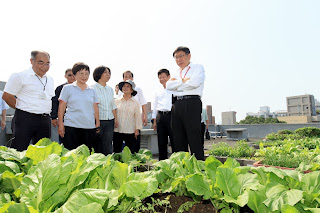In 2015, Taipei mayor Ko Wen-Je pulled off his “Farm City” project which aimed to bring back the urban agriculture by establishing more “edible landscapes” that, as he believed, would contribute to the urban ecosystem and relieve the overloaded stress of city dwellers.[1]
Three years passed, has Taipei successfully built the path that allowed nature to make its way back into the city?
Managing a mega city like Taipei is a conundrum even for the most brilliant mayor. With more than 6 million habitants living in the Taipei-New Taipei metropolis, heavy traffic and unavoidable gridlocks during the rush hour remind all of us of a terrifying truth: our city is chocking.
Particulate air pollution is horrendous and fatal, commonly exists in modern cities. Taipei is not excluded. It allegedly causes 3.2 million premature deaths annually, in both rural and urban area worldwide.[2] As a plethora of urban policies were raised to tackle this problem, such as the diesel cars ban[3] and the subsidy of public transportation,[4] one solution is proved to be the most cost-effective and beneficial: Greenery.
Nature provides remarkable benefits to a city.[5] Gardens by the bay in Singapore, The High Line in New York, Stanley Park in Vancouver, lots of green spaces have become iconic or even spiritual symbols for a city. And this trend of “make the city green again” was officially introduced in Taipei in 2015.
“This farm is definitely an invaluable asset for the district,” said Felly Tsai, a 66-year-old retiree, “It is a communal area for neighbors to communicate and to know one another better and people also felt satisfied to know where their food comes from.” She volunteers at the “Happiness Farm” in Songshan district, one of the most visited and prosperous farms under the Farm City project.
Most residents recognize these city farms as a non-toxic food source and recreation places for the neighborhood and more examples like this are emerging on the rooftops of public buildings and schools around the whole city. Nevertheless, at the same time, their limits also gradually well up.

“Initially, this project was directed to provoke the community awareness and to beautify the city,” said Shilun Huang from Napcufarming, an NGO that lobbied this greenery policy during the mayoral election. “It’s true that a sense of belonging is widely established within the community because of these farms, but most people work on the farm for growing their own vegetables and wish to bring them home someday. Not everyone thinks about its connection to the urban ecosystem.”
This phenomenon seems to explain why this project hasn’t revolutionized our daily street views. Not to mention to a degree where the additional greenery could help us to purify our air quality. Moreover, concerning its restrictions on potential farmlands and eligible adopters,[6] it is obvious that a long way is still ahead before this project upgrades to a bottom-up action. Until recently, only limited farms were successfully led and created by the citizens and the intervention from the government seems still indispensable.[7]
Even so, on the other side of the world, a group of green fingers is currently leveraging their inherited aesthetic consciousness and civic awareness to transform the most romantic city in the world into a verdant cosmopolitan hub.
The French capital of Paris chose to coordinate with its citizens against the urban environmental crisis. Le permis de végétaliser that is, the license to vegetate, is an initiative that encouraged Parisians to treat the whole city as their own gardens. Before 2030, the city hall aims to grow 20,000 new trees and roll out 100 hectares of vegetation across the city’s street corners, walls, and rooftops with the shared efforts of its residents.

“Besides the closer relations among neighbors, the unlimited creativity from the citizens is what surprises us the most,” said Pénélope Komitès, leader of the green spaces department in the municipality. “The dose of greenery not only brings the city to life, but also contributes to allay the unbearable summer heat derived from global warming, air pollution, and increasing population in Paris.”
Given more freedom from its municipality to decide where and what to plant, the plantation in Paris is no longer restricted to certain designated spaces like parks or schools. Even though sometimes it means the potential aesthetic crisis(vandalism or eccentric floral arrangement). But by doing so, the greenery could finally spread out to the entire city and everyone’s daily life. This scene is what we still extremely lack in Taipei.
Greenery means more than planting more trees, the approaches being taken and the motivation of participants also determine its outcome. Above all, we all wish to live in a city where the air is fresh, the temperature is moderate, and plenty of green is enjoyed by not only us but all other urban creatures. Most importantly, it is the city we proudly created together.
By Chris Chang for Collective Green
[1] 田園城市推廣實施計畫p.9, [2] The Nature Conservancy(NC)- Planting Healthy Air Report p.9, [3] Reuter- German court says Frankfurt must ban older diesel cars, [4] https://english.metro.taipei/cp.aspx?n=BECC2E7AC426F659&s=BAB2F2CF94748BDB, [5] Planting Healthy Air Report P.21, [6] 田園城市推廣實施計畫 P18.19, [7] https://udn.com/news/story/11322/3066529, [8] Charte de végétalisation de l’espace public parisien, [9] photograph by Steve Garvie, distributed under a CC-BY 2.0 license

